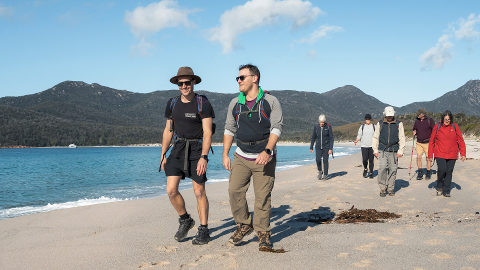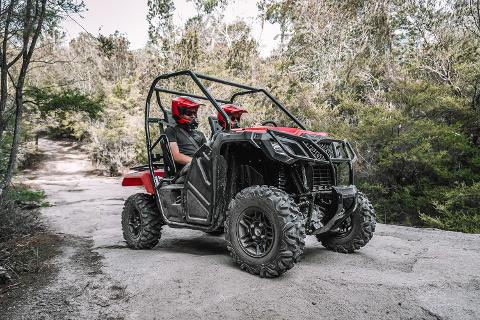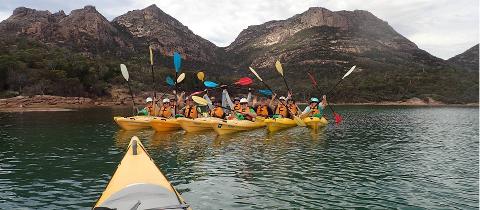Freycinet National Park was named after the French explorer Louis de Freycinet (1779 - 1841), who sailed through the area around 1800. Home to Tasmania’s most photographed view and situated on the breathtaking east coast, you will find Freycinet National Park stretched out along the peninsula overlooking the Tasman Sea and surrounded by the dramatic peaks of the Hazards.
Thousands of people are attracted to the pristine coastal environments and the benefits of rural and isolated settings every year. The powder-white beaches and transparent waters of Tasmania’s oldest park formed over 400 million years, meet the rugged coastal bushland where native wildlife roams, including Eastern Quolls and Red-necked Wallabies. In fact, Freycinet is home to 49 species that can only be found in Tasmania.
Spring (September to November):
Spring is ideal for those who want to enjoy mild weather and blooming wildflowers. The temperatures are moderate, making it perfect for hiking and exploring the park. Wildlife activity increases as animals become more visible after winter.
Summer (December to February):
Summer is the most popular time to visit due to warm weather, perfect for beach activities like swimming, kayaking, and sunbathing at Wineglass Bay. However, it’s also the busiest season, so expect more tourists. Book accommodations and tours in advance.
Autumn (March to May):
Autumn offers mild temperatures and fewer crowds, making it a great time to visit if you prefer a quieter experience. The water is still warm enough for activities, and the fall colors add to the park’s beauty.
Winter (June to August):
While it’s colder in winter, this season offers a peaceful atmosphere with fewer tourists. Hiking trails are less crowded, and you can still enjoy the park’s dramatic landscapes. This is also a great time for wildlife spotting, especially marine life like dolphins and whales.
 Freycinet National Park is approximately 2.5 hours to 3 hours drive from either Hobart or Launceston. All roads to Freycinet are sealed, so a 4WD is not needed. Drive cautiously from dusk to dawn and keep a lookout for wallabies and wombats. Since you will be sharing the road with a range of wildlife, an advisory speed limit of 60 km/h applies on the roads to and from the park after dark. Follow the coastline of Freycinet National Park to find the secluded Wineglass Bay, one of the world's top 10 beaches, with its pink granite peaks towering over crystal clear waters.
Freycinet National Park is approximately 2.5 hours to 3 hours drive from either Hobart or Launceston. All roads to Freycinet are sealed, so a 4WD is not needed. Drive cautiously from dusk to dawn and keep a lookout for wallabies and wombats. Since you will be sharing the road with a range of wildlife, an advisory speed limit of 60 km/h applies on the roads to and from the park after dark. Follow the coastline of Freycinet National Park to find the secluded Wineglass Bay, one of the world's top 10 beaches, with its pink granite peaks towering over crystal clear waters.
The small holiday town of Coles Bay borders the park, and the largest nearby town is Swansea. Walking tracks along the coastline cater to all abilities, whether you’re a leisurely stroller, wishing to take in the scenery on a half day walk, or an avid adventurer setting out on a 2-4 day trek along the entire length of the peninsula, including Bryans Beach and Cooks Beach. Stop off in Coles Bay before setting out to stock up on food and water supplies. Image thanks to Aydan Marrier.
Kayak, snorkel, dive or swim in the clear waters to get up close to abundant marine life. Come up for a breath of fresh air and you may even spot a White-bellied Sea Eagle gliding overhead, or an Australasian Gannet diving beneath the waves for a feed. At days end, pack a picnic (or just grab a locally woodfired pizza and a bottle of pinot from the Devil’s Corner Cellar Door) and stick around on the sand to see the pink granite of the Hazards glow pink at sunset. Keep a look out and if you’re extra lucky, catch a rare glimpse of the long term local residents - the Tassie Devils.
 Freycinet National Park is administered by the Parks and Wildlife Service of Tasmania. The visitor centre is well worth a visit from 9 am-4 pm all year round, retelling the region’s cultural and natural heritage through creative displays. You can participate in a tour or get to the significant locations by car or bicycle. The dramatic peaks of the Hazards welcome you as you enter the park. Take a walk to the pass overlooking the perfectly shaped Wineglass Bay, or try less strenuous activities like beach strolls, swimming or wildlife spotting. Image thanks to: Flow Mountain Bike.
Freycinet National Park is administered by the Parks and Wildlife Service of Tasmania. The visitor centre is well worth a visit from 9 am-4 pm all year round, retelling the region’s cultural and natural heritage through creative displays. You can participate in a tour or get to the significant locations by car or bicycle. The dramatic peaks of the Hazards welcome you as you enter the park. Take a walk to the pass overlooking the perfectly shaped Wineglass Bay, or try less strenuous activities like beach strolls, swimming or wildlife spotting. Image thanks to: Flow Mountain Bike.
At the Freycinet National Park Centre you can buy your park passes and find postcards, clothing, posters and a large collection of natural history books in the adjoining shop.
Do you need a Park Pass?
All visitors must have a park pass to enter Freycinet National Park. The pass contributes to the conservation and upkeep of Tasmania’s national parks, protecting its stunning landscapes and wildlife. Here are the available options:
- Day Pass: Perfect for short visits, this pass is valid for 24 hours.
- Holiday Pass: Ideal for more extended stays, this pass is valid for up to two months and allows entry to all national parks in Tasmania.
- Annual All Parks Pass: If you plan to visit multiple times throughout the year, this pass provides unlimited access to all of Tasmania’s national parks for an entire year.
You can purchase your park pass:
- Online via the Tasmania Parks & Wildlife Service website
- At local visitor centers
- At the park entrance itself
Find more information at the Parks and Wildlife Services of Tasmania's Freycinet National Park Section.
 There are many walks to choose from across the park with a variety of lengths and degrees of difficulty. Be sure to bring water, wear proper walking shoes, and have a good map. Longer walks can be more difficult and you should prepare by bringing basic first aid equipment, snacks, and raincoats for changing weather. Image thanks to Tourism Tasmania & Geoffrey Lea.
There are many walks to choose from across the park with a variety of lengths and degrees of difficulty. Be sure to bring water, wear proper walking shoes, and have a good map. Longer walks can be more difficult and you should prepare by bringing basic first aid equipment, snacks, and raincoats for changing weather. Image thanks to Tourism Tasmania & Geoffrey Lea.
Be sure to check the weather before planning the walks. Aside from these examples, there are other shorter walks which are worth taking. There are also many scenic drives around Freycinet that are worth a look including around Cape Tourville and The Friendly Beaches.
The park’s role in conservation is particularly significant due to the vast diversity of its landscape. You will be sharing the park with wonderful plants and animals alike. As in the rest of Tasmania, the vegetation in Freycinet National Park is indicative of temperature ranges and precipitation. More than 500 plants have been recorded within the park, including over 80 species of orchids. Several species have a restricted distribution and many others are listed under the Tasmanian Threatened Species Protection Act 1995 (TSP Act).
 Wildlife is one of the many treasures of Freycinet. Please take note that the feeding of animals in the park is strictly prohibited and fines will be imposed if you are caught. Mammals found include the Red-necked Wallaby, Eastern Quoll, Brushtail Possum, Ringtail Possum, Sugar Glider, Eastern Pygmy Possum, Little Pygmy Possum, Echidna, wombats, New Holland Mouse, Swamp Rat, Water Rat, Tasmanian Bettong and the Long-nosed Potoroo. Cetaceans such as Southern Right Whale, Humpback Whale, and Bottlenose Dolphins are known to use the bay to feed, calve or to take rests. There are also numerous reptiles that are found at Freycinet including lizards, skinks and snakes. Image thanks to Tourism Tasmania & Petra Harris.
Wildlife is one of the many treasures of Freycinet. Please take note that the feeding of animals in the park is strictly prohibited and fines will be imposed if you are caught. Mammals found include the Red-necked Wallaby, Eastern Quoll, Brushtail Possum, Ringtail Possum, Sugar Glider, Eastern Pygmy Possum, Little Pygmy Possum, Echidna, wombats, New Holland Mouse, Swamp Rat, Water Rat, Tasmanian Bettong and the Long-nosed Potoroo. Cetaceans such as Southern Right Whale, Humpback Whale, and Bottlenose Dolphins are known to use the bay to feed, calve or to take rests. There are also numerous reptiles that are found at Freycinet including lizards, skinks and snakes. Image thanks to Tourism Tasmania & Petra Harris.
Native Mammals
One of the most commonly seen animals is the Bennett's Wallaby, which can often be found near campsites and picnic areas. These friendly creatures aren’t shy around visitors and offer plenty of photo opportunities. The park is also home to Eastern Quolls, small carnivorous marsupials with distinctive white spots, which are best spotted at dawn or dusk. You might also encounter Tasmanian Pademelons, a smaller species of wallaby, hopping through the forest undergrowth, while the elusive wombat may be spotted at night, foraging for food along the trails. While they are quite elusive and primarily nocturnal, you can also find Tasmanian Devils at Freycinet National Park.
Marine Life
The marine life around Freycinet is equally captivating. Dolphins are frequently seen playing off the coast, particularly around Wineglass Bay, and lucky visitors might catch sight of them leaping from the water while on a boat or kayaking tour. Australian fur seals are another common sight, often lounging on coastal rocks or swimming nearby. During whale migration seasons, typically between May to July and September to December, you might even spot humpback whales or southern right whales as they pass by the peninsula.
Birds
If you’re a keen birdwatcher, make sure you pick up the area’s bird spotting guide from the park’s entry station on the way in. Owing to the varying ecosystems in Freycinet there are many species of birds that either inhabit or fly through the park. The Moulting Lagoon is a RAMSAR wetland sanctuary and home to black swans, waterfowl and a range of other migratory birdlife. You may also be lucky enough to see a white-bellied sea-eagle gliding overhead or large Australasian gannet diving for food in the ocean. They range from large predator species such as the brown falcon (Falco berigora) to smaller species including the fairy-wren (Malurus cyaneus) and flame robin (Petroica phoenicea). Flocks of yellow-tailed black cockatoos are also a common sight, their loud calls echoing through the trees. If you’re near the coast at dusk, you may be lucky enough to spot little penguins returning to their nests after a day at sea. There are also several species which are listed on the TSP Act.
Reptiles and Insects
Freycinet’s reptile and amphibian inhabitants are no less interesting. Near freshwater streams, you might hear the calls of Tasmanian tree frogs, and on warm, sunny days, blotched blue-tongue lizards can be found basking on rocks. For an extra touch of magic, you can seek out colonies of glow worms that light up the park’s dark, damp caves and sheltered trails at night.
Best Times for Wildlife Spotting
- Dawn and Dusk are ideal for seeing many of the native mammals like wallabies, wombats, and quolls.
- Spring and Summer offer the best chances to see migrating marine life like dolphins and whales, as well as an abundance of bird activity.
Accommodation in and around Freycinet National Park ranges from onsite camping to luxury eco-retreats, with much of it located in the village of Coles Bay near the park entrance.
You need a camping permit to camp at Freycinet. Due to the high demand for campsites, a ballot system drawn in early August is implemented from the 18th of December until the 10th of February and during Easter each year. To protect the park’s natural environment, camping is restricted to barrier areas within allocated sites.
The nearby coastal towns of Swanick, Swansea and Bicheno also have a range of places to stay ranging from luxury to budget accomodation standards.
Quick Highlights:
- Freycinet National Park Campsites: Ideal for those looking to immerse themselves in nature, with access to incredible hiking trails and beach views.
- Cradle Mountain Discovery Holiday Park: A perfect spot for camping near one of Tasmania's most iconic natural landmarks, with easy access to hiking trails like the Dove Lake Circuit.
- Cockle Creek Campsite: Offers a remote and wild camping experience, ideal for exploring the southern end of Tasmania and for wildlife watching, particularly seals and birds.
- Bruny Island Caravan Park: Bruny Island offers stunning coastal views, wildlife experiences, and a slower pace. Perfect for a relaxed camping trip with access to nearby beaches and hiking trails.
 Visit Coles Bay’s cafes and restaurants to enjoy a wide range of cuisine. Savor everything from coffee to a gourmet farm-to-table dinner of fresh local ingredients. Seafood lovers will appreciate the produce, including east coast oysters, mussels, rock lobster, and scallops. There are also a range of vineyards around the area which are open for wine tasting. Image thanks to: Tourism Tasmania & Rob Burnett.
Visit Coles Bay’s cafes and restaurants to enjoy a wide range of cuisine. Savor everything from coffee to a gourmet farm-to-table dinner of fresh local ingredients. Seafood lovers will appreciate the produce, including east coast oysters, mussels, rock lobster, and scallops. There are also a range of vineyards around the area which are open for wine tasting. Image thanks to: Tourism Tasmania & Rob Burnett.
Quick Highlights:
- Freycinet Marine Farm: Famous for its fresh oysters, mussels, and scallops straight from the farm. This is a great stop for a casual meal where you can enjoy seafood platters in a relaxed outdoor setting.
- The Edge Restaurant: Offering breathtaking views of The Hazards mountain range, this restaurant features a seasonal menu with fresh, local ingredients. The Edge is perfect for a romantic dinner or a special occasion.
- Geographe Restaurant & Espresso Bar: Known for its delicious coffee, wood-fired pizzas, and burgers, Geographe is a great spot for a quick, tasty bite after a day of exploring the park.
- Tombolo Freycinet: Enjoy gourmet wood-fired pizzas with a view of Freycinet’s stunning landscapes. Tombolo is a laid-back spot for families and groups looking for a casual meal.
- Freycinet Lodge – Bay Restaurant: Offers a more refined dining experience with an emphasis on local produce and seafood. Guests can enjoy a multi-course meal with a stunning view over Great Oyster Bay.
- The Fishers at Coles Bay: Specializes in takeaway fish and chips with the freshest catch of the day. It's a casual and budget-friendly option for seafood lovers.























































